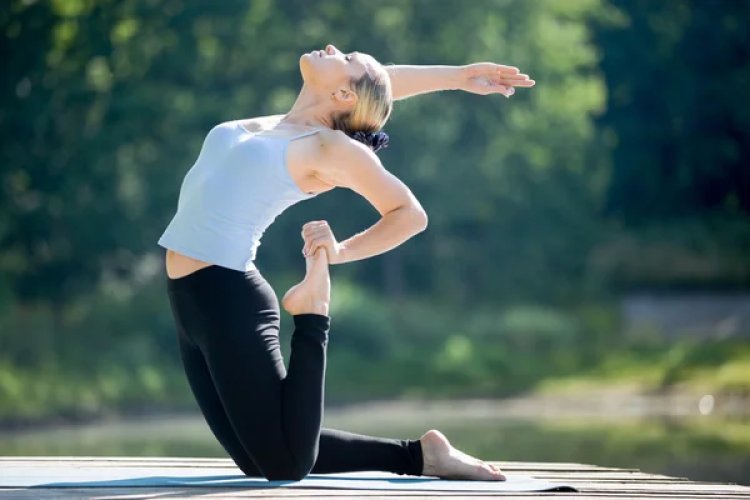8 Yoga Poses for Beginners
There are numerous benefits to incorporating yoga into your exercise regimen. Here are defining 8 Yoga Poses for Beginners

8 Yoga Poses for Beginners: There are numerous benefits to incorporating yoga into your exercise regimen. Yoga enhances muscle tone, flexibility, and balance, and its signature pranayama breathing helps you relax and reduce tension. In addition, research has demonstrated that yogic practices reduce tension, anxiety, melancholy, and chronic pain, improve sleep, and enhance overall health and quality of life.
Willing to give it a shot? Here are eight "asanas" recommended by yoga instructors for beginners.
Eight Yoga Poses for Beginners are:
Easy Pose — Sukhasana — to Relieve Stress
Cross-legged on a yoga mat, place your palms-up forearms on your knees. Keep your back as erect as possible. In yoga parlance, press your "sit bones" (the bones you're seated on) into the floor. Close your eyes and take a deep breath.
"This is a great pose for beginners to use as an assessment," says Gwen Lawrence, yoga instructor for the New York Knicks and other professional sports teams and celebrities. Simply seated on the floor allows one to observe and sense the external rotation of the legs. In addition to increasing back flexibility, this pose can help relieve tension.
Cat-Cow to Awaken the Spine and Ease Back Pain
Position your hands directly below your shoulders and your knees directly below your hips while on all fours on your mat. Spread your fingertips apart and distribute your weight evenly between your palms. Inhale and arch your back while lowering your jaw to your torso; feel the stretch from your neck to your tailbone, as if you were a cat. As you exhale, lower your back until it forms a scoop and raise and turn your head backward.
"Cat-Cow stretches and awakens the spine, which helps alleviate back pain," says Leah Cullis, a Baptiste Yoga instructor. "It also increases the mobility and flexibility of the entire vertebrae, neck, torso, and shoulders. I suggest repeating five to ten times or more."
Tree Pose — Vrksasana — to Improve Your Balance
Start by standing straight for this pose. Bring your hands together in the prayer position and lift them over your head. Balance on your right leg. Bend your left knee out to the left side and press your left foot to the inner thigh of your right leg. Hold for 30 seconds. Switch legs and repeat.
Downward-Facing Dog — Adho Mukha Svanasana — to Enhance Flexibility
In Downward-Facing Dog, the body creates a V-shaped inversion. Place both hands, palms down, on the mat in front of you; your hands should be slightly in front of your shoulders. Place your knees directly beneath your pelvis on the ground. Exhale as you elevate your legs off the ground and your buttocks and hips upwards. Pull the tops of your quadriceps back while extending your legs toward the floor. Keep your head between your upper limbs, in line with them, and not drooping. If your lower back is rounding, consider bending your ankles to lengthen it.
"Downward-Facing Dog calms the nervous system, works on overall flexibility, decompresses the spine, tones the arms, sculpts the legs, and opens the shoulders," says Cullis. Typically, the pose is held for five breaths per side, or longer for additional strength-building benefits. Cullis suggests that you lengthen from your wrists to your hips on your inhales and deepen your roots from your hips to your soles on your exhales.
Child's Pose — Balasana — to Help You Relax and Unwind
From Downward-Facing Dog, bow your knees and lower your butt to your heels while bringing your torso closer to the floor over your knees. Reduce your head and shoulders to the floor. You can support your head by placing your arms along your sides, palms down, or by curling your arms under your cranium. Breathe and unwind for as long as necessary.
"Child's Pose is one of the most restorative yoga positions, and my personal favorite," says Cullis. "It reawakens the connection between the respiration and the body and transmits calming energy to all the muscles. It is a chance to get grounded, turn inward, and leave your active mind and enter your body by awakening your breath from the inside out. Child's Pose is an excellent way to unwind and take a break during your yoga practice, or whenever you feel exhausted or overburdened.
Baby Pigeon Pose to Open Up Your Hips
Move your right knee forward between your palms while on all fours. As if performing a lunge, gently extend your left leg behind you, retaining your knee and the top of your foot on the ground. Now, rotate the right knee toward the right wrist and lower it to the floor, placing the right calf level on the floor and the right foot under the left pelvis. Lower your upper body over the bowed leg to the floor or to your forearms, depending on your comfort level. Inhale and exhale slowly five times. Before switching sides, extend your left calf by pushing back on your left leg. Repeat with the left leg extended and the right leg bowed.
This pose is favored by runners because it increases pelvic flexibility and relieves the glutes and low back, according to Lawrence. "If you run, lift weights, participate in CrossFit or Spin, you must perform this stretch to maintain strength and flexibility and improve your performance." Lawrence guarantees that despite the initial difficulty, you will grow to enjoy this pose.
Mountain Pose — Tadasana — to Improve Your Posture
Feel your feet on the floor, as well as the sensations in your legs and back, while standing still with your torso open and your hands at your sides. Afterward, evaluate your posture in front of a mirror. While standing, Lawrence requires her athletes to grasp lengthy pencils in each hand. "I instruct them to gaze at the pencils and, like a compass, determine which direction they indicate. Are they identical? Does one point directly and the other to three o'clock on the clock?"
This pose will reveal if you have any shoulder imbalances and provide insight into what you need to work on. If a pencil is extremely angled inward, then so is your shoulder.
Legs-up-the-Wall Pose — Viparita Karani — to Restore and Revitalize
This is an excellent closing pose for both novice and advanced yoga practitioners. Lie on the ground with your butt against the wall. Your body should be in a L configuration with your torso horizontal on the floor and perpendicular to the wall as you "walk" your legs up the wall. Consider placing a rolled-up blanket under your lower back for support; keep your elbows out to the sides on the floor for added support. To sense a stretch in the backs of your legs, flex your ankles. Deeply inhale and maintain the position for as long as you desire. Bring your knees to your chest and rotate onto your side to discharge.
According to Lawrence, this pose rejuvenates weary legs and gives you a renewed spring in your step.
Hope these 8 Yoga Poses for Beginners will be helpful to you




















